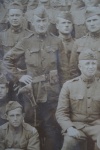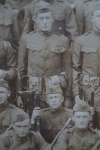
|
Amazing WW1 US Army 3rd Division "ROCK OF THE MARNE" Company Photograph Armed with Browning BAR Rifles |
Over the years, I've visited A LOT of antique shops/malls. In just about every one you'll almost invariably find one of these large military group photographs. Usually, they're in the form of graduation photographs from some type of training before being shipped overseas and most date to World War 2. I have the utmost respect for what these men and women did in serving our country in uniform and it has been a real honor to see so many over the years. One of the things that rarely seems to turn up are group photographs taken of combat units beyond basic or advanced warfare training. They're almost taken before a group ships out, never afterwards. That said, this World War One photograph of Company H of the 4th US Army Infantry, 3rd Division really surprised me! It's after a group gets back and before they disband and become lost to time. There are over 200 men in this photo, so many that it's three feet long and about nine inches tall. For starters, I noticed their painted 3rd Division helmets and we currently have one of these painted helmets in inventory. Here was a photograph with literally dozens of this same identical helmet. The next thing I noticed were these men were actually armed with their issued weapons, not the run of the mill parade rifles or rifle range guns you normally see. These soldiers were holding well-used Springfield Model 1903 rifles, some holstered Colt 1911 pistols were also visible, and on the front row there was something that really stunned me. There were four men holding something I'd only read about in books, the new Model 1918 Browning Automatic Rifles or BARs for short. These were produced by Colt and Winchester but only saw action in the last few battles of 1918 before the war ended. Other than some publicity photographs taken of Val Browning (the son of the inventor) holding one while was in the US Army, I had never seen one in the hands of a combat unit. The next thing I noticed was that this photograph was marked: COMPANY "H" 4TH INFANTRY 3RD DIV MARNE DIV: In this photograph are the surviving veterans of the famous and highly revered "Rock of the Marne" division taken right after they got off the boat back home from from the war in 1919. There is so much that can be learned from this one photograph in terms of history, uniforms, insignia, weapons, and technology, that it's incredible. Many of these men survived the battles of Chateau Thierry in July 1918 where the 3rd Division helped stop the last German offensive of the First World War along the Marne River, earning it the nickname "Rock of the Marne". When many of the French units began retreating, the 3rd Division held firm. It's commanding officer stated to the French, "Nous resterons la"...."We are staying there". And that they did, effectively blunting the last German advance of the war. These men also participated in the Saint Mihiel offensive in Sept. 1918 which was followed by fighting on the front lines from Sept. 30th to October 27th, 1918 during the Meuse Argonne offensive. In my reading about the 4th Infantry, it is my understanding that this regiment took 80% casualties in the Meuse Argonne offensive in those thirty days. Now, I could begin to get a glimpse into some of the expressions on the faces of those 200+ Americans staring into the camera of this photograph. Some of these guys look like they've had been through to Hell and back and it wasn't difficult to realize why once I learned its history. I couldn't help but notice the face of one of the BAR men on the front row...about eighth from the right. No words can describe that look. The intensity and glare of one of the young company lieutenants seated front and center lets you know as if he's saying, "I'm in charge here", no doubt about it. I spotted what had to be an older sergeant standing behind the three lieutenants to the left; his wrinkled uniform, bulging pockets, and his holstered Colt 1911 sort of sagging with the leg strap undone. You can also see what I would imagine are the company troublemakers in the middle of the fifth row. There are all kinds of expressions and each one has a story I'm certain. Uniforms: If you look closely at the left arm sleeves on their uniforms, you'll notice that many have two stripes or chevrons. These aren't ranks but overseas service stripes given for each six months of active duty. A regiment that arrived in the spring of 1918 and came home in mid-1919 will have soldiers wearing two of these chevrons and many do. Because of the pose, you cannot see them all but some you can see. In a few cases, you'll see a soldier wearing only one stripe. This man would have been a replacement from around the end of the war. Remember, this unit sustained quite a few casualties. Also, not all soldiers put their overseas chevrons on their sleeves and there are some guys who have none. These could be new guys or ones who never bothered to sew them on. If a soldier were wounded, he would be given the chance to wear a small chevron on the lower right arm of his uniform. The first man to the left of the three lieutenants seated in the middle of the front row has a wounded insignia that is clearly visible. Most of the soldiers have 3rd Division patches with the three diagonal blue stripes on the white background. In many case, their helmets are visible and have the same painted symbol on the front. I've been told that most of these helmets were painted with their division markings after the war ended...as it would have been far from safe to have such a bright logo on the top of your head peering out of a trench. One of the things I learned from this photo are how the soldiers used their chin-straps to sling their helmets over their shoulders. Another thing you'll notice on many of the soldiers are wristwatches. Prior to World War One, most men carried pocket watches but the war economized the time needed to tell "time" by strapping wrist band to pocket watches. Given the absolute imperative that troops be able to make coordinated movements across lines spread out over miles, the wristwatch was a matter of life and death. In fact, the ability to read time at night introduced a new type of dial which was often painted with radioactive paint. I can remember reading about one of the first class action lawsuits ever filed in the United States, on the behalf of the many women who suffered health problems and worse from licking the fine paint brushes in order to paint these watch dials. If you've ever seen an original uniform from this war, you'll notice that the pants have cuffs that stop several inches above the ankle. Living in trenches in France was a muddy affair and soldiers would wrap up their legs from their boots to almost their knees to keep the mud at bay. You'll also notice that quite a few soldiers have whistles attached to their top coat pockets. Again, these were used for signaling various things to one another as well as other units. Weapons: As you can see, there are lots and lots of men with Model 1903 Springfield Bolt Action rifles in 30-06. This rifle was developed from lessons learned in the Spanish-American War and it was largely patterned from the Model 1893 Mauser rifle in 7mm captured in Cuba in 1898. When the first World War started, there was a significant shortage of these rifles as the Springfield Armory could not produce enough to arm all American troops. Fortunately, Winchester and Remington and Eddystone had tooled up to produce the P-17 Enfield rifles and these lines were quickly converted to producing a modified version called the Model 1917. Most American soldiers, about 2/3, received the Model 1917. These men are all armed with the Model 1903 Springfields. There are also several Model 1911 Colt Automatic pistols but all are in holsters. If you look closely, you can see the diamond checkered pattern on the bottom of the walnut grips and quite a few men show the 1911 magazine pouches in the rows although you can't always see the holsters. There are also the BAR men and while there are four on the front row, there are also a few more BAR men in rows further back. In some cases, you can see the flash hiders which the Model 1903 Springfields do not have. You can also see that these men have special utility belts with a box or cup above the right hip. Those BAR's were quite heavy and during an offensive, were supposed to be fired from the hip in what was called "walking fire" to suppress enemy fire. These cups were used to support the BAR's from the buttstock, thus taking some of the weight off the arms of the soldier carrying it. The photograph is in its original wood frame which is painted black. The photograph is marked in left corner with the name of the photographer..PRAGOFF on West 128th Street, NYC. At 98 years old, it is a slightly faded but in Very Good Condition. We can only wonder who in this unit must have had this up on his wall throughout his life. I've never seen a better First World War photo of a decorated combat unit with their equipment than this one. Item# 1929 SOLD |
 |
 |
 |
 |
 |
 |
 |
 |
 |
 |
 |